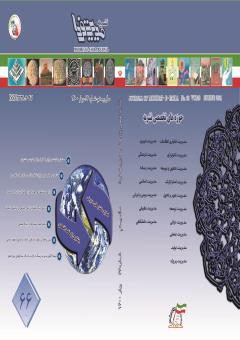Investigating the Factors Affecting the Performance Evaluation of Social Security Brokers in Isfahan Province
Subject Areas :seyedhamid Ghoreishi 1 , seyedalireza ebrahimi 2
1 - phd student of Salami Azad University, Semnan branch
2 - Assistant Professor of Public Administration Department of Semnan University
Keywords: Performance Evaluation, Customers, Chief Executive Officers, Employees, Social Security,
Abstract :
Abstract Background: Any organization needs to be evaluated for awareness of the desirability and quality of its activities, especially in complex and dynamic environments. On the other hand, the lack of a system of evaluation and control in a system means that it isn't communicating with the inner and outer environment, which implies that is aged and ultimately the death of the organization. In this regard, the present study was conducted with the aim of designing a performance evaluation model for social security agencies in Isfahan province. The purpose of this research is application and developmental type. Methodology: The population of the present study consisted of all experts and experts in the field of social security, managers, staff and clients of social security agencies of Isfahan province, which reported about 10,300 people in 1398. The research sample was determined using the Morgan table of 373 individuals. Data were gathered by field method and a researcher-made questionnaire was used for data collection. SmartPLS software was used for data analysis and analysis. Results:The findings showed that customers'viewpoint had a significant effect on the evaluation of the overall performance of the brokerage (t=2.291,p<0.01). Also, the effect of headline managers'view on evaluating the overall performance of the brokerage firm (t=1.988,p<0.05) is significant. However, the effect of employee's view on performance evaluation (t=0.242) wasn't significant. Conclusion: According to the results of the research, it can be said that in evaluating the performance of the organization, in addition to employees and management, customers have a significant role.
آبـروان، مهرداد.(1393). طراحـي شـاخص¬هاي نظـام ارزيابـي عملکرد براسـاس کارت ارزيابـي متـوازن BSC در سـازمان تأميـن اجتماعـي. پايـان نامـه كارشناسـي ارشـد منتشرنشـده، دانشـگاه آزاد اسـامي واحد نيشـابور. نيشـابور .
استيري، مهرداد و شريفي، مهدي.( 1395). شناسايي و ارزيابي اقدامات سيستم هاي کاري با عملکرد بالا در صنعت خدمات بانکداري کشور. فصلنامه نوآوري و ارزش آفريني، 5( 10)، 93-108.
حسنپور، اکبر و مهدوي، هومان.( 1397). راهکارهاي ارتقاي ابعاد اخلاقي در نظام ارزيابي عملکرد کارکنان.اخلاق در علوم و فناوري، 13(3)، 108-115.
خاتمــي، سيد محمد .(1394). بررســي و رتبه¬بنــدي شــاخص¬هاي ارزيابــي عملكــرد بانــك ملــي بــا اســتفاده از مــدل كارت امتيــاز متــوازن و AHP فــازي بــا تأكيــد بــرشــاخصهاي مالــي. ماهنامــه پژوهشــهاي مديريــت و حســابداري. 14، 13-65.
رجوعي، مرتضي، رمضاني، مريم، حصاري، محمدرضا و بوربورجعفري، مريم.( 1396). طراحي شاخصهاي ارزيابي عملکرد با استفاده از روشهاي BSCوAHP در سازمان تأمين اجتماعي مشهد. فصلنامه علمي- پژوهشي رفاه اجتماعي، 17( 64)، 158-131.
رضايي نور، جلال و عنايتي، فرزانه.( 1395). ارائه مدلي براي ارزيابي عملکرد واحدهاي مرکز رشد با ترکيب روش¬هاي کارت امتيازي متوازن، تحليل شبکه¬اي و پرومته. فصلنامه مديريت توسعه فناوري، 3(5)، 97-75.
عباسي، عباس، رعنايي کردشولي، حبيب الله و اصغري جهرمي، سمانه.( 1395). طراحي الگوي ارزشيابي عملکرد کارکنان بر مبناي مدل¬هاي ارزيابي عملکرد سازماني براي سازمان¬هاي دولتي ايران. فصلنامه پژوهش-هاي مديريت منابع انساني دانشگاه امام حسين(ع)، 8( 4)، 213-235.
کاپلان و نورتون (1388). خودآموز ارزيابي متوازن، ترجمه نصرآزاداني، انتشارات ارکان دانش.
محمــودي، جعفر،پوررضــا، ناصر و تربتــي، امير.( 1391). لگويــي بــراي شناســايي شـاخص¬هاي کليـدي عملکـرد بـا اسـتفاده از کارت امتيابـي متـوازن و پويايي¬هـاي سيســتم، توســعه انساني پليــس، 9( 42)، 29-48.
سازمان تأمين اجتماعي (1395). وزارت اقتصاد و برنامه¬ريزي. در دسترس درhttp://www.tehran.sso.ir.
Arban, A and Buglino, L (2003). A multimentional performance model for consolidating balanced scorecards. Journal of advances in engineering software, 34,2003, 339-349.
Hung-Yi, W. Gwo-Hshiung, T. and Yi-Hsuan Ch. (2009). A fuzzy MCDM approach for evaluating banking performance based on Balanced Scorecard. Expert Sysems with Applications, 36,2009, 10135–10147.
Propper, C and Deborah, W (2003). The Use and Usefulness of Performance Measures in the Public Sector. The Centre for Market and Public Organisation 03/073, Department of Economics, University of Brisol, UK.
Papp, R (1999). Business-ITalignment: productivity paradox payoff?. Journal:Indusrial Management &Data sysems, Vol 99, No 8,1999, pp. 367-373.
Tan, H. P., D. Plowman, and P. Hancock (2017). Intellectual capital and financial returns of companies. Journal of Intellectual Capital.Vol 8, No1, 2017, pp.76-95.
Pietrzak, Michał, Joanna Paliszkiewicz, and Bogdan Klepacki (2015).The application of the balanced scorecard (BSC) in the higher education setting of a Polish university". Journalof Applied Knowledge Management Vol3, No1,2015, 151-164.
Iveta, M, Vladimira, B and Libor,K(2017). Planning and performance evaluation of the anufacturing organizations , Procedia Engineering 192, 46-51.


